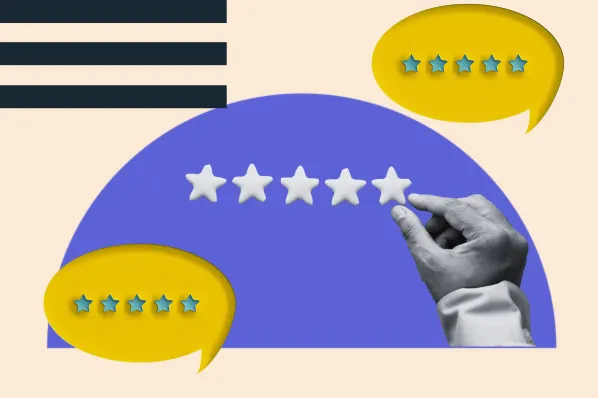With sky-high competition and constantly shifting expectations, a strong brand reputation isn’t solely enough to acquire new customers and retain existing ones.
You need an airtight customer experience (CX) strategy to delight your customers and win their loyalty.
In this post, I’ll break down 15 defining trends that will shape the customer service industry and influence your strategy in 2024. I’ve identified these trends based on insights from our latest State of Service research.
Let’s dive in to decode what the future of CX holds for you.
Customer Experience Trends and Statistics
- Improving customer retention and loyalty is the top priority for 31% of customer service leaders.
- Understanding customer needs is one of the biggest challenges in delivering an exceptional customer experience.
- 86% of respondents believe AI will have a transformative impact on customer experience.
- 71% of leaders plan on increasing their investment in AI chatbots for customer service.
- Self-service and customer intelligence are two of the biggest investment areas for using AI in customer service.
- A majority of leaders want to build better alignment between the customer success team and other departments.
- 55% of customers prefer self-serve customer service channels in comparison to speaking to a support representative.
- AI chatbots and live chat are the two most popular service channels in 2024.
- 34% of CS leaders plan on making their first investment in building a mobile app for customer service.
- 85% of leaders believe their ability to scale customer service operations alongside business growth has significantly or somewhat improved.
- 54% of leaders believe a human assisted by AI is the best choice for resolving complex support requests.
- 46% of customers expect more personalized communications to trust a brand.
- 67% of customers expect a resolution within three hours.
- 79% of leaders believe customer service should be available across all channels that customers use.
- 45% of organizations are going to invest in customer journey analytics.
Above are 15 crucial trends from the latest customer experience research to shape your strategy. Next, let’s break down this data to learn what it could mean for your company.
.webp)
Free Customer Journey Template
Outline your company's customer journey and experience with these 7 free templates.
- Buyer's Journey Template
- Future State Template
- Day-in-the-Life Template
- And more!
Download Free
All fields are required.
.webp)
1. Improving customer retention and loyalty is the top priority for 31% of customer service leaders.
Loyalty is one of the biggest driving factors behind CX success. Instead of chasing short-sighted wins by offering deals and discounts, companies want to establish a strong rapport with their customers, which sets them up for long-term success.
That explains why 31% of leaders want to maximize retention and consider customer loyalty as their most important objective in 2024. To that end, increasing the customer satisfaction (CSAT) score is an equally important goal.
Here are some other priorities for customer service leaders:
- Offering a personalized experience at scale (26%).
- Understanding and implementing customer feedback (25%).
- Streamlining customer experience operations (25%).
2. Understanding customer needs is one of the biggest challenges in delivering an exceptional customer experience.
Customer expectations are constantly changing. 22% of surveyed leaders consider it difficult to understand customer needs. Meanwhile, 21% find it difficult to adapt to increasingly demanding expectations.
That is to say, customer service teams struggle to adapt their CX strategy to fulfill these evolving needs and end up compromising customer loyalty.
The key is to set realistic expectations for customers and proactively guide them to success. You need regular surveys, direct conversations, and behavioral data to identify the points of friction in CX. Then, make necessary improvements.
3. 86% of respondents believe AI will have a transformative impact on customer experience.
AI has disrupted almost every industry, and the customer service vertical is no exception. A whopping 86% of CX leaders believe AI will help them transform the experience they deliver to their customers.
This data suggests an overwhelming shift toward building an AI-powered infrastructure to enhance CX.
Companies are gearing up to use AI tools to level up many aspects of their customer service, such as personalized responses, sentiment analysis, on-demand guidance, and more.
In fact, 77% of respondents believe that AI will be able to handle a majority of customer tickets without an agent by 2025.
4. 71% of leaders plan on increasing their investment in AI chatbots for customer service.
As AI technology becomes more advanced and sophisticated, it can fulfill more diverse needs for the customer service industry.
While CX teams have actively embraced AI to streamline their operations, more than two-thirds (71%) of CX leaders will increase their investment in AI chatbots for delivering support in 2024. A mere 2% plan to decrease their investment for this use case.
5. Self-service and customer intelligence are two of the biggest investment areas for using AI in customer service.
McKinsey’s research concludes that 23% of customer care leaders are planning to invest more in building self-service chatbots, and 21% will focus on building customer intelligence with conversational AI tools.
Here are some other areas of investment in AI for customer service:
- CX hyper-personalization (18%).
- Knowledge-based searchability (18%).
- Automated post-call summary (10%).
It’s important to note that companies are still exploring the far-reaching potential of AI technology to create a seamless customer experience. So, these use cases and investment priorities will keep evolving as new solutions hit the market.
6. A majority of leaders want to build better alignment between the customer success team and other departments.
When asked about their most high-impact investment area for 2024, 11% of respondents want to invest in improving collaboration between customer success and other functions.
A cross-functional setup gives CS teams a more dynamic understanding of their customers. They can talk to sales and marketing teams to learn nuanced details about customers and create detailed personas to tailor the customer experience.
Besides building stronger team alignment, two other top priorities for CX leaders this year are using AI and delivering omni-channel support.
7. 55% of customers prefer self-serve customer service channels in comparison to speaking to a support representative.
Gone are the days when customers had the time (or patience) to wait in line and speak to a support agent to resolve queries. Today, they want to troubleshoot problems and find answers independently at their own pace.
With 55% of customers preferring to go through a self-service channel (like a knowledge base or chatbot), one thing is clear: You have to enable people to solve issues on their own.
But there’s also a generational angle to this insight.
Gartner’s research indicates that Gen Z (39%) and Millennials (38%) are more likely to give up on solving a problem if they can’t find answers on their own. On the flip side, a majority of Gen X and Baby Boomers will only abandon a situation after contacting multiple people about it.
8. AI chatbots and live chat are the two most popular service channels in 2024.
We live in the golden age of instant messaging. From placing a food delivery order to booking tickets for a concert, everything happens in an instant. So, why shouldn’t accessing support also be a matter of seconds?
As customer expectations increasingly turn toward round-the-clock support, companies are planning to invest more in quick and convenient support channels: AI chatbots and live chats with support reps.
32% of leaders collectively prioritize these channels over others as part of their CX strategy.
The key to success with AI lies in an incremental use strategy. You should start by using AI to maximize your support agents’ productivity and reduce response times. Then, scale it gradually for more customer-facing use cases.
9. 34% of CS leaders plan on making their first investment in building a mobile app for customer service.
Instant support isn’t limited to building an AI chatbot. Companies are also embracing new avenues to deliver quality support round-the-clock.
34% of CX leaders are planning to build a mobile app as one of their new service channels.
Here’s why. Mobile apps allow customers to access self-serve support resources or chat with an agent anytime, anywhere. They can resolve issues even while they’re traveling. Put simply, mobile app support can remove blockers for your customers and deliver a more convenient experience.
10. 85% of leaders believe their ability to scale customer service operations alongside business growth has significantly or somewhat improved.
38% of surveyed leaders believe they’ve significantly improved their ability to scale the CS operations as the business grows.
Nearly half (47%) of them believe they’ve somewhat improved this scalability part of operational growth. And that’s where the problem lies.
Even with so much excitement around the promise of AI, many companies are still in the early stages of implementing this technology. They’re not sure of the challenges they might face when scaling CX operations, like reliability, technical issues, safety and security concerns, and more.
According to McKinsey’s research, the lack of AI maturity and governance is a huge challenge for 22% of customer care leaders.
11. 54% of leaders believe a human assisted by AI is the best choice for resolving complex support requests.
More than half (54%) of surveyed respondents consider it best to strike a balance between AI and human support. Empowering your CS agents to leverage AI tools can help you deliver faster and more accurate solutions to end-users.
You can build systems and workflows to help CS reps understand customer issues and offer resolutions quickly.
For example, you can use an AI tool to interpret every query and present a few relevant resources to guide the customer. This allows the agent to reduce response time because they don’t have to manually look for the right resource.
12. 46% of customers expect more personalized communications to trust a brand.
Cold, generic messaging won’t cut it anymore. Your customers want to feel seen and heard with 46% of them looking for personalization communication across multiple touchpoints.
You can personalize different parts of the customer journey to gain their confidence. For example, you can onboard new customers with a welcome kit tailored to their details, like name, company, package, etc.
Personalization also goes a long way in email marketing. You can create multiple customer segments and customize your messaging for each persona.
13. 67% of customers expect a resolution within three hours.
Every business has a customer service team. But what sets the best ones apart from the rest? It’s the time taken to resolve customer queries.
21% of customers expect a resolution immediately. 23% will wait for a maximum of an hour to find answers, while another 23% can wait up to three hours.
These tight timelines for ticket resolution can only mean one thing — the faster you deliver support, the happier your customers will be. And speed can be your biggest differentiator because it determines what customers think of your brand as a whole.
14. 79% of leaders believe customer service should be available across all channels that customers use.
Your customers hang out on multiple platforms. They expect the convenience to get your help or guidance anywhere, anytime.
That’s why omni-channel support has been at the top of the priority list for many customer service leaders. Today, it’s become more important than ever to create a seamless omni-channel customer experience, with 79% of respondents claiming it’s important to be available across all channels that customers use.
15. 45% of organizations are going to invest in customer journey analytics.
Gartner’s research shows that 50% of organizations already have a customer journey analytics (CJA) setup, while 45% will start investing in it in the next 12 to 18 months.
These tools offer a holistic understanding of the customer journey, capturing the customer intent at different stages and identifying where they need more support. A CJA setup can give you clear directions to shape your CX strategy and improve communication across touchpoints.
Build Your Winning CX Strategy for 2024
Companies have to constantly adapt their CX strategy to understand and fulfill evolving customer expectations. That’s why investing in AI — combined with human expertise — can give you a competitive edge.
Beyond AI, the CX winners of tomorrow are actively prioritizing speed, personalization, and omni-channel support. You also have to be on top of your customer journey to remove friction and deliver a hassle-free experience that your customers will love.
Editor's note: This post was originally published in April 2018 and has been updated for comprehensiveness.













